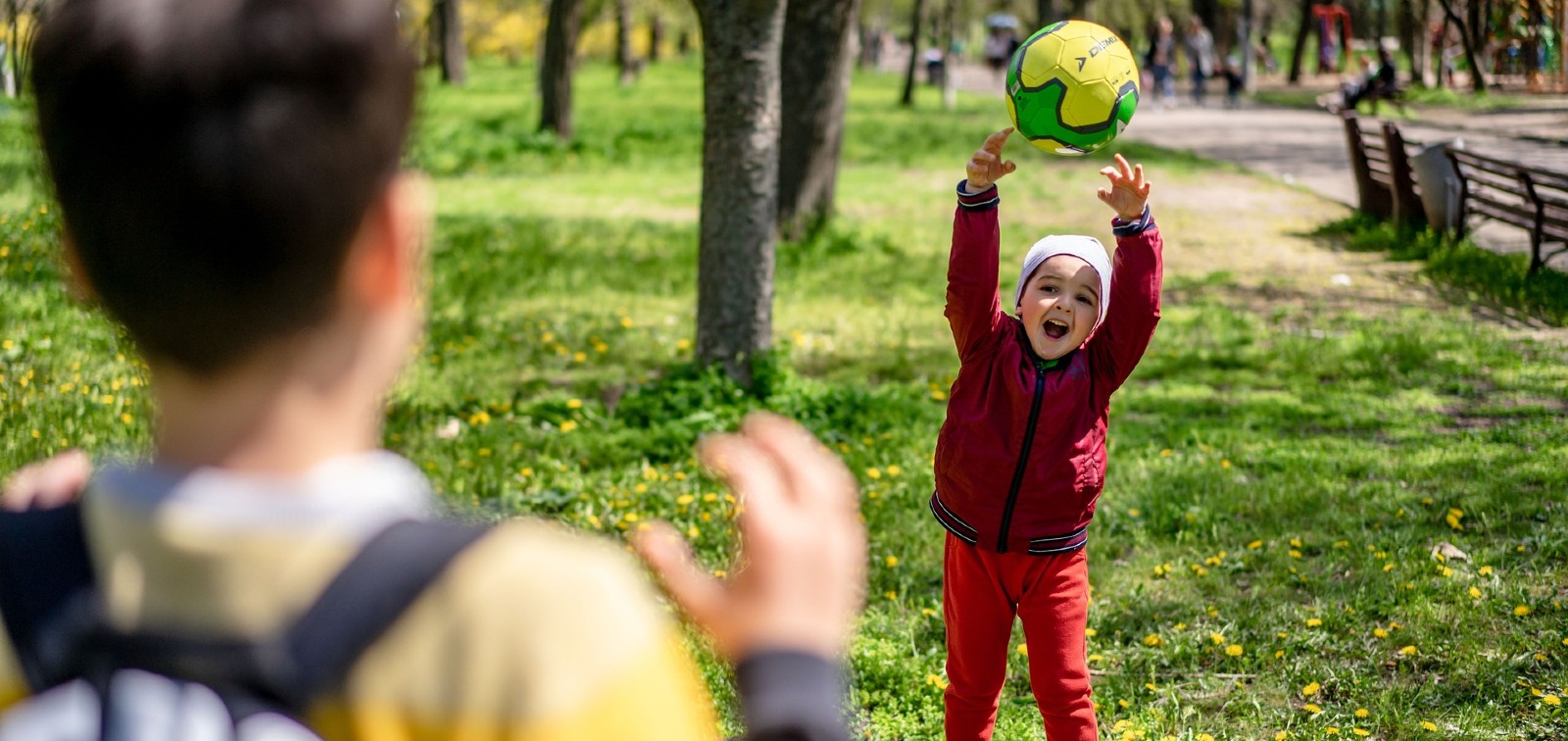Even Before Birth, Children Are More Vulnerable and Have More Health Problems Caused by Environmental Factors Than Adults
The latest FAROS report proposes interventions to ensure air quality in schools, where children spend most of their time, and to convert playgrounds into small natural spaces
10.11.2022
In recent years, climate change has been transforming the economy and physiognomy of countries and subjecting their populations to extreme temperatures, heat and cold waves, natural disasters, epidemics, water shortages and more. Spain is among the European countries considered most vulnerable to climate change.
This phenomenon is compounded by other environmental factors that have a negative impact on people’s health, including air pollution, noise, persistent organic pollutants, pesticides and chemical agents. Against this backdrop, the most recent report by FAROS, the health promotion observatory at Sant Joan de Déu Barcelona Hospital, analyses the impacts of all these environmental factors on children’s health. The report was coordinated by specialists at Sant Joan de Déu Barcelona Hospital and the Barcelona Institute for Global Health (ISGlobal), a centre supported by the “la Caixa” Foundation.
Even before they are born, children are more vulnerable than adults to environmental hazards. Air pollution, persistent organic pollutants, pesticides and chemical agents that women are exposed to during pregnancy are harmful to the health, metabolism, neurodevelopment, and respiratory and immune function of newborn babies—and these effects extend far beyond the perinatal period into adulthood.
Some studies have suggested that certain environmental pollutants can cross the placental barrier and even modify the baby’s DNA. This is why experts advise couples who wish to have children to be especially careful about exposure to these substances—watching their diet and avoiding the use of household products that may contain certain chemicals—even before conceiving a child.
Air Pollution
There is a direct relationship between urban design, how people get around and the effects on environmental exposure. Large volumes of traffic also lead to high levels of air pollution. Children are particularly vulnerable to air pollution because, due to physiological differences (e.g. proportionally high respiratory rate) and behavioural differences (e.g. high levels of physical activity), they can be exposed to higher doses of air pollutants than adults.
In Barcelona, nearly 50% of childhood asthma cases are attributable to air pollution, according to a study by ISGlobal researchers. Worldwide, 93% of children breathe air that does not meet the quality criteria set by the World Health Organisation, resulting in 600,000 premature child deaths each year.
More Cases of Bronchiolitis in the ICU
A recent study led by researchers at Sant Joan de Déu Barcelona Hospital–Sant Joan de Déu Research Institute showed that children are at increased risk of being admitted to the ICU with a severe rhinovirus infection when exposed to high levels of nitrogen oxides (environmental pollutants emitted by cars and certain industrial facilities). This virus, which is responsible for the common cold, usually causes mild illness, but a small percentage of patients develop more severe symptoms—bronchiolitis and bronchial spasms—and require hospital admission.
The researchers analysed 150 admissions to the ICU at Sant Joan de Déu Barcelona Hospital from the Baix Llobregat southern metropolitan area over the course of nine years (2010-2018). After comparing these data with various environmental indicators—temperature, airborne pollen levels, nitrogen compound levels, rainfall, etc.—they found that the number of patients admitted to the ICU with a rhinovirus infection increased three days after an increase in nitrogen oxide levels was recorded.
Cities, where a majority of the world’s population is now concentrated, are affected by very high levels of noise and the so-called heat island effect (higher temperatures due to the density of buildings and roads and a lack of green space).
Interventions in Schools
The authors of the 13th FAROS report—entitled El ambiente y su impacto en la salud maternoinfantil ¿A qué nos enfrentamos? ("The Environment and its Impact on Maternal and Child Health: What Are We Up Against?”)—believe it is necessary to take action in cities to reduce these negative environmental factors. In the case of children, the authors propose interventions to ensure air quality in schools, where children spend most of their time. Specifically, they propose planting more trees in school playgrounds, creating green walls that provide shade, and installing fountains and play areas, among other ideas. The aim is to reduce air pollution, noise and the heat island effect, while also encouraging physical activity (which reduces the incidence of diabetes and other obesity-related diseases). The authors also point out that converting playgrounds into small, biodiverse natural spaces also helps to improve children’s immune systems in a very short time.
The report’s authors also encourage families to spend time in natural settings. Only 20% of today’s children and adolescents play outdoors at least once a month—down from a rate of three out of four in their parents’ generation. Only 10% visit a park on a daily basis. The authors of the report note that this lack of contact with nature encourages a sedentary lifestyle and acts as a key factor in the rise of obesity, respiratory and cardiovascular diseases, behavioural disorders, attention disorders, worsening of chronic diseases, low vitamin levels, etc. Conversely, contact with nature confers many benefits: better sleep, improved motor neurodevelopment, reduced anxiety and stress, and higher academic achievement, among other things.
Environmental Pollutants Affect Neurodevelopment
Approximately 20% of children under 18 years of age have some kind of neurodevelopmental alteration or difficulty. Scientific studies have pointed to the role of environmental pollutants in increasing the prevalence of these disorders.
Many metals easily cross the placental barrier, resulting in direct exposure to the foetus during pregnancy, as evidenced by the concentrations of these metals found in umbilical cord blood at birth. The blood-brain barrier, which protects the brain from toxic chemicals, is not fully formed until six months after birth, opening a direct window of vulnerability for the developing brain, both in the womb and during the early postnatal period. Moreover, children are more exposed to environmental pollutants because they consume more food than adults relative to their weight; the same is true for the volume of air they breathe and the amount of water they drink.
Studies in both animals and humans have shown that a variety of chemicals found in our natural environments and in our homes—lead, methylmercury, pesticides, manganese, etc.—can interact with our genes and contribute to various neurodevelopmental disorders. The authors of the report therefore include a series of practical recommendations that families can apply in their daily lives to prevent or minimise the effect of these environmental factors, including paying attention to air quality indicators published by local meteorological agencies in order to either restrict or encourage children’s outdoor activities; spending time in natural settings; airing out their homes outside of peak traffic hours; not consuming hot water from the tap; taking precautions with plastic containers; and watching what foods children consume.
Mental Health Problems
Environmental changes brought about by globalisation and climate change are also affecting mood and mental health in the general population, as well as in children and adolescents.
Children and young people are more likely to be affected by eco-anxiety, a state of chronic fear and worry that, while not a disease, is a consequence of observing the impact of climate change. Young people who suffer from eco-anxiety experience moodiness, helplessness, feelings of anger and rage, panic, guilt, etc.
The report includes a series of practical recommendations for parents to help them detect these problems, as well as suggestions on how to help: listening to their children, proposing actions to reduce the effects of climate change and participate in collective climate awareness actions, and encouraging contact with nature because it allows the prefrontal cortex to “rest” from stress.




